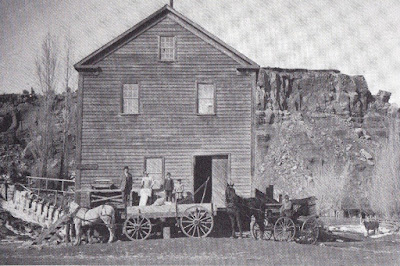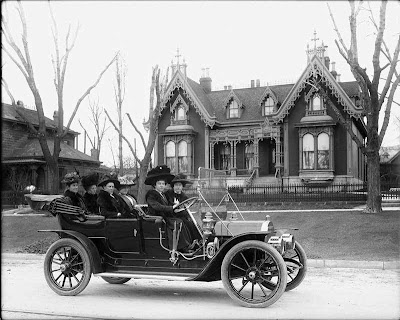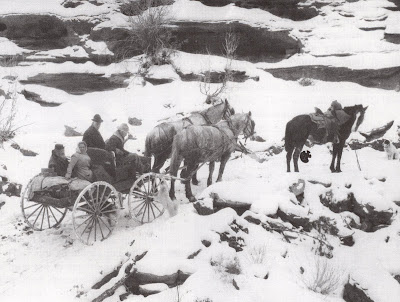A Story of Maren Hansen’s Daughter
History of Ellen Pederson
Sorenson;
Written
by Lois Jane Sorenson (daughter-in-law)
 |
| 7th Handcart Co. |
Marren,
the mother, had been married before to a man by the name of Nielsen (it is not
known if he died or not). She had two
children by this marriage, a boy named Hans Peter and a little red-headed girl
which they called Stina.
In
the year 1858 a child was born to Ellen’s mother and Father, they gave the name
of Kiraten. This family was contacted by
the Mormon Elders and converted to the church.
They were baptized about the year 1856 in Denmark. After joining the church their friends and
relatives mistreated them very severely and they decided to set sail to
American to be with the Saints in Utah.
 |
| Oxen and Wagon |
Ellen’s
father and mother bought three yoke of oxen and a cow and started across the
plains to Utah. Hans Peter driving the
cow, the mother riding whenever she could.
Ellen remembers walking most of the way.
She and her little sister gathered buffalow chips in their aprons so that
they could have a fire at night.
The
cow gave enough milk that the family had all the milk they needed, also Marren
made butter, which was enjoyed by many of the Saints, what was left shared with
the other Saints.
 |
| Peter Boel, Herman and Gideon Tweede, John HafenAdd caption |
Ellen,
a little girl of seven, loved to pick Indian beads out of the ant beds and
string them for necklaces. She says that
the ants never bothered her. She also
remembers her father being left by the company and having to walk all night to
catch up.
Arriving
in Utah in 1862 or ’63 they settled in Ephraim for two years. Later they moved to Richfield. The family lived in a little two-roomed house
with a dirt floor.
The
town of Richfield grew very fast from log cabins to adobe houses. Ellen’s father was a carpenter and he made
them beds, tables, chairs, and many other items of furniture. The children sat on three-legged stools and
Ellen remembers cooking many meals in the bake skillet over the coals in an
open fireplace. At this time they burned
grass wood using the ashes for soap to wash their clothes. What was left over was saved and later made
into candles which was their only way of lighting at night.
Ellen
had very little schooling but was very talented in cording and sewing. She spun many yards of cloth, sewed many mens
suits, shirts and other clothing. She
has spun as high as seven scans in one day.
 |
| Silk making |
After
this terrible experience President Young told the people of Richfield to move
away, to go north to more populated areas.
This
was hard for the Saints as they were finally being settled down after so much
traveling. However, the Pedersons like
all the rest left their homes and returned back to Ephriam about the first of
April 1867.
It
was here that Maren, their mother who had been through so many hardships,
became ill and passed away on 28 December 1867, leaving her husband and three
children alone.
 |
| Stage Coach |
This family went through many hardships
without their mother, however Marren had taught Ellen the routine of household
duties and so Ellen had to do these tasks.
At times they barely had enough to go around but they were thankful for
what they had, and regardless of how tough times got their father always seemed
to pay his obligations and tithing to the church.
After the Indian trouble had settled
down again they returned to Richfield.
This was in 1872. She was a very
good housekeeper and kept their little house very clean. She even moped the dirt floor each day to
keep the dust away until her father was able to put boards down, this she would
scrub each day.
At this time Jens Sorensen had come to
Utah from Denmark, he had the privilege of riding the first train that came
into Ogden with the Saints. He later
traveled on to Glenwood with P.C. Petersen about 1872, by visiting around with
different people he met the Peder Pedersen family. He enjoyed going to their home for some good
meals and visiting with the young people.
He thought Ellen was a very good housekeeper and cook and this was where
his love began to grow. Ellen also
became interested in Jens and fell in love with him. They both enjoyed talking Danish. On 9 November 1874 this young couple were
married in the
Endowment House in Salt Lake City, they made their trip by ox
team. Jens had a little one room log
cabin with a few pieces of furniture.
Some was made during United Order.
So it was to this little home they abided. Ellen with her good housekeeping soon had it
a very nice little place and a real home for them. She continued making candles, washing and
cording wool, spinning it and helping to clear many acres of land. She would clean the grain, then would take
cloth for furniture which was then made at Ephriam. (At the age of 70 she still had a wardrobe of
this homemade nature and her spinning wheel is a present in the Daughters of
Pioneer Relic Hall in Glenwood in memory of her.)
 |
| Glenwood house |
They lived in the United Order as long as it
was in force. So they knew how to
share. It lasted for about five years.
In July 1878 their first child was born
to them. Ellen made some beautiful
clothes for her then named her Mary Ellen Sorensen. April 4, 1881 their second child was born. This child was called Annie Kirsteen. She was a little dark headed girl.
Dora Dort a little girl was born in this
new home, 4 December 1883 just in time for Christmas which made the family very
happy.
 |
| Glenwood Mill |
Twelfth March 1886 another girl baby was
born. They named her Millie, this made
quite a family for Ellen to cloth and feed.
In August 5, 1888 Huldah Adamma a pretty
little red haired girl came to earth.
It was at this time that the manifesto was signed that
plural marriage was to cease. The men
had to go in hiding from the officers as they came around. The officers of the law came and took their
husband Jens, this was a sad occasion but a common one at this time.
On November 8, 1891 their first son,
James Elmer was born a little red headed guy, how proud and happy they were to
finally have a son. On January 6, 1895
another little boy came along and was given the named of Peter Erlen but his
stay here on earth wasn’t long as he died on February 8, 1895. This was hard for them, but Ellen and Jens
had been blessed as this was the tenth child for Jens and the seventh for Ellen
and the first line broken in the two families.
August 12, 1896 a little blond boy was
born to Jens and Ellen, and given the name of Vern Ernest, two years later
twins were born to Larsena and Jens (Lyman and Alima).
This made 13 children in all completed
to two families.
Ellen taught her children to work along
with her. She was a good wife and mother
but very stern in her ways, she was very good to give of her substance to
anyone in need. For years she churned butter
and sold it. She would go with her horse
and buggy to Richfield with her pounds and pounds of butter each week, summer
or winter. As each of her children grew
up and made homes of their own she made a good grandmother.
They all loved to go to her home, they
knew she always had good homemade buns for them to eat.
 She was a Relief Society block Teacher
for many years. She worked in all of the
Organizations but on the account of her having very little schooling she was
unable to write. However, she was a very
good reader and thus was well read and versed.
Her husband kept their family records.
She was active in the church as long as her health would permit it.
She was a Relief Society block Teacher
for many years. She worked in all of the
Organizations but on the account of her having very little schooling she was
unable to write. However, she was a very
good reader and thus was well read and versed.
Her husband kept their family records.
She was active in the church as long as her health would permit it.
She was in Richfield to a Stake
conference when she took her first stroke and from that time on her health
failed her. Huldah took care of her
until she needed some one with her all the time. At this point her oldest daughter Mary took
her into her home and cared for her.
She was there when she had her third
stroke, and she passed away in Mary’s home on Tuesday evening May 16, 1939, at
the age of 82.
Her funeral services were May 19, 1939,
presided over by her son Bishop Elmer Sorensen, conducted by Counselor Albert
Oldroyd. She lived through a choice time
and saw many changes in the world. From
people crossing the plains and living in dugouts to our moderns homes of
today. And from the ox teams to the high
powered automobiles of today also from candles to electric lights.
She had many friends where ever she
went. At the time of her death she had
six living children, 26 grandchildren, 12 great-grandchildren and a half sister
Caroline Nielsen.
A Story
of Maren Hansen’s Son
Hans
Peter Nielsen 1845-1909--- Ellen
Pederson 1856-1939
Both buried at Richfield Cemetery
Ellen Pedersen was born 29
June 1856 at, Praesto, Denmark, to Maren Hansen and Peder Pedersen
We
did not know our Grandfather, Hans Peter Nielsen. He passed away (1909) before our mother was
married. We know he was a grist miller,
and excellent carpenter, and a skilled builder.
We have seen and enjoyed visiting some of the buildings he built. The home we spent most of our lives in,
Grandfather built for our Grandparents, William and Sarah G. Meeks. He worked well with his family, especially
his sons and son-in-law, Nels Hanson, an excellent and much sought after
skilled carpenter.
Grandfather
and Grandma had an aesthetic appreciation for nature. Because of this they
built the grist mill, their home and other essential buildings in a most
beautiful, serene spot near Bicknell on the Fremont River, with large gorgeous
red cliffs in the background. We do not
have a picture of Grandpa Nielsen, but from our mother’s description he was not
a large man, sandy complexioned, with kind blue eyes and looked like the “Good
Miller Man”.
The Story of the Grist Mill and Planing
Mill
By Matilda Nielsen Meeks
 |
Mill with grandfather |
His occupation was milling. He ran the mill at
Richfield. They were driven back and
forth three different times by the Indians to Richfield, Ephraim and Elsinor,
and would or had to pile sacks of grain up to the windows and bar the doors to
keep the Indians out and from shooting at them.
He carried and old musket gun with him.
He kept it hung on the wall where he could get it easily.
He
built and owned a mill at Richfield up by the Spring Ditch in the year of 1882.
He came to Thurber, Wayne County the year of 1890, for
the purpose of milling. He built and ran
the mill now standing down by the Dirty Devil River (Fremont River) by the
bridge. He ran it by water power. He ran and kept the mill up to his death,
1909. It was sold to the King Brothers
in the year 1910. Father brought with
him the old musket gun and had it hung on the wall. An old Indian called Grey Head recognized the
gun from the mills at Richfield and Ephraim.
He said, “I that many times and could have killed you.”
 |
| Father Nielson , Ed Nielson |
Father worked real hard. He lived to be sixty four years old. He died 18 September 1909 and was buried in
Wayne County and afterward moved him from the Bicknell Cemetery to the
Richfield Cemetery.
Grandma used to go to Richfield to shop. One day as she was walking down the side-walk
she heard someone calling behind her, trying to catch up to her, “Good Miller
Man’s Squaw, stop! Stop! It was an
Indian squaw, Tewank’s sister, and she had been to Grandpa’s Mill in Bicknell
many times and pick up pinenuts. The
Indians tied their sacks with a special knot so that they could tell if someone
had opened it.










